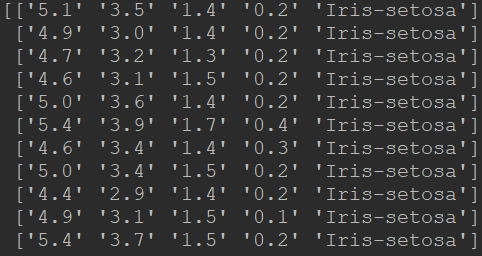数据集地址
基于sklearn接口的分类
from sklearn.ensemble import GradientBoostingClassifier
from sklearn.metrics import accuracy_score
from sklearn.model_selection import train_test_split
from sklearn.preprocessing import OneHotEncoder
from sklearn.externals import joblib
import numpy as np
# 以分隔符,读取文件,得到的是一个二维列表
iris = np.loadtxt('iris.data', dtype=str, delimiter=',', unpack=False, encoding='utf-8')
# 前4列是特征
data = iris[:, :4].astype(np.float)
# 最后一列是标签,我们将其转换为二维列表
target = iris[:, -1][:, np.newaxis]
# 对标签进行onehot编码后还原成数字
enc = OneHotEncoder()
target = enc.fit_transform(target).astype(np.int).toarray()
target = [list(oh).index(1) for oh in target]
# 划分训练数据和测试数据
X_train, X_test, y_train, y_test = train_test_split(data, target, test_size=0.2, random_state=1)
# 模型训练
gbdt = GradientBoostingClassifier(n_estimators=3000, max_depth=2, min_samples_split=2, learning_rate=0.1)
gbdt.fit(X_train, y_train)
# 模型存储
joblib.dump(gbdt, 'gbdt_model.pkl')
# 模型加载
gbdt = joblib.load('gbdt_model.pkl')
# 模型预测
y_pred = gbdt.predict(X_test)
# 模型评估
print('The accuracy of prediction is:', accuracy_score(y_test, y_pred))
# 特征重要度
print('Feature importances:', list(gbdt.feature_importances_))
结果
The accuracy of prediction is: 0.9666666666666667
Feature importances: [0.002148238569679191, 0.0046703830672789074, 0.33366676380518245, 0.6595146145578594]
进行超参数搜索
from sklearn.ensemble import GradientBoostingClassifier
from sklearn.model_selection import train_test_split, GridSearchCV
from sklearn.preprocessing import OneHotEncoder
import numpy as np
# 以分隔符,读取文件,得到的是一个二维列表
iris = np.loadtxt('iris.data', dtype=str, delimiter=',', unpack=False, encoding='utf-8')
# 前4列是特征
data = iris[:, :4].astype(np.float)
# 最后一列是标签,我们将其转换为二维列表
target = iris[:, -1][:, np.newaxis]
# 对标签进行onehot编码后还原成数字
enc = OneHotEncoder()
target = enc.fit_transform(target).astype(np.int).toarray()
target = [list(oh).index(1) for oh in target]
# 划分训练数据和测试数据
X_train, X_test, y_train, y_test = train_test_split(data, target, test_size=0.2, random_state=1)
estimator = GradientBoostingClassifier()
param_grid = {
'learning_rate': [0.05, 0.1,],
'n_estimators': [2000, 3000],
'max_depth': [2, 3, ],
'min_samples_split': [2, 3],
}
gbm = GridSearchCV(estimator, param_grid)
gbm.fit(X_train, y_train)
print('Best parameters found by grid search are:', gbm.best_params_)
结果:
Best parameters found by grid search are: {'learning_rate': 0.05, 'max_depth': 2, 'min_samples_split': 2, 'n_estimators': 2000}
基于sklearn接口的回归
from sklearn.datasets import make_regression
from sklearn.ensemble import GradientBoostingRegressor
from sklearn.model_selection import train_test_split
import lightgbm as lgb
from sklearn.metrics import mean_absolute_error
X, y = make_regression(n_samples=100, n_features=1, noise=20)
# 切分训练集、测试集
train_X, test_X, train_y, test_y = train_test_split(X, y, test_size=0.25, random_state=1)
# 调用GBDT模型,使用训练集数据进行训练(拟合)
my_model = GradientBoostingRegressor(
loss='ls'
, learning_rate=0.1
, n_estimators=100
, subsample=1
, min_samples_split=2
, min_samples_leaf=1
, max_depth=3
, init=None
, random_state=None
, max_features=None
, alpha=0.9
, verbose=0
, max_leaf_nodes=None
, warm_start=False
)
my_model.fit(train_X, train_y)
# 使用模型对测试集数据进行预测
predictions = my_model.predict(test_X)
# 对模型的预测结果进行评判(平均绝对误差)
print("Mean Absolute Error : " + str(mean_absolute_error(predictions, test_y)))
结果:
Mean Absolute Error : 19.30372190886058
